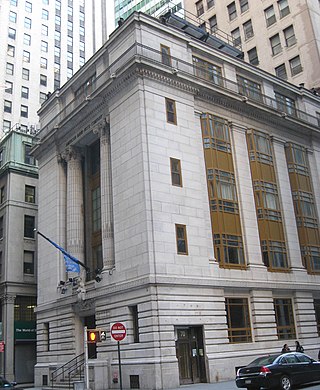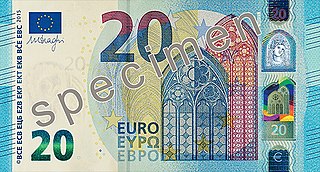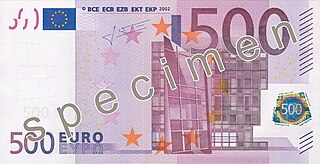
A banknote—also called a bill, paper money, or simply a note—is a type of negotiable promissory note, made by a bank or other licensed authority, payable to the bearer on demand. Banknotes were originally issued by commercial banks, which were legally required to redeem the notes for legal tender when presented to the chief cashier of the originating bank. These commercial banknotes only traded at face value in the market served by the issuing bank. Commercial banknotes have primarily been replaced by national banknotes issued by central banks or monetary authorities.

The rupee is the currency of the Seychelles. It is subdivided into 100 cents. In the local Seychellois Creole (Seselwa) language, it is called the roupi and roupie in French. The ISO code is SCR. The abbreviation SR is sometimes used for distinction. By population, Seychelles is the smallest country to have an independent monetary policy. Several other currencies are also called rupee.

The United States one-hundred-dollar bill ($100) is a denomination of United States currency. The first United States Note with this value was issued in 1862 and the Federal Reserve Note version was first produced in 1914. Inventor and U.S. Founding Father Benjamin Franklin has been featured on the obverse of the bill since 1914, which now also contains stylized images of the Declaration of Independence, a quill pen, the Syng inkwell, and the Liberty Bell. The reverse depicts Independence Hall in Philadelphia, which it has featured since 1928.

Security printing is the field of the printing industry that deals with the printing of items such as banknotes, cheques, passports, tamper-evident labels, security tapes, product authentication, stock certificates, postage stamps and identity cards. The main goal of security printing is to prevent forgery, tampering, or counterfeiting. More recently many of the techniques used to protect these high-value documents have become more available to commercial printers, whether they are using the more traditional offset and flexographic presses or the newer digital platforms. Businesses are protecting their lesser-value documents such as transcripts, coupons and prescription pads by incorporating some of the features listed below to ensure that they cannot be forged or that alteration of the data cannot occur undetected.
De La Rue plc is a British company headquartered in Basingstoke, England, that produces secure digital and physical protections for goods, trade, and identities in 140 countries. It sells to governments, central banks, and businesses. Its Authentication division provides Government revenue technology, brand protection, and ID security, such as polycarbonate data pages for passports. Its Currency division designs and produces banknotes, secure polymer substrate and banknote security features. This includes security holograms, security threads and security printed products for central banks and currency issuing authorities. It is listed on the London Stock Exchange. It is the world's largest commercial printer of banknotes.
A currency detector or currency validator is a device that determines whether notes or coins are genuine or counterfeit. These devices are used in a wide range of automated machines, such as retail kiosks, supermarket self checkout machines, arcade gaming machines, payphones, launderette washing machines, car park ticket machines, automatic fare collection machines, public transport ticket machines, and vending machines.

ABCorp, formerly the American Bank Note Company, is an American corporation providing contract manufacturing and related services to the authentication, payment and secure access business sectors. Its history dates back to 1795 as a secure engraver and printer, and assisting the newly formed First Bank of the United States to design and produce more counterfeit resistant currency. The company has facilities in the United States, Canada, Australia, and New Zealand.

The Crane and Company Old Stone Mill Rag Room is one of the oldest surviving buildings of Crane & Co., one of the oldest papermaking businesses in Berkshire County, Massachusetts. It is located in southwestern Dalton, on a site where paper has been manufactured since the early 19th century. The building, originally used for processing rags, has housed the Crane Museum of Papermaking since 1930, and was designated a National Historic Landmark in 1983.

The five-euro note (€5) is the lowest value euro banknote. It has been used since the introduction of the euro in 2002. The note is used in the 25 countries that have it as their sole currency, which countries have a total population of about 343 million currently. In July 2023, there were approximately 2,159,000,000 five-euro banknotes in circulation around the eurozone. It is the fifth-most widely circulated denomination, accounting for 7.2% of the total banknotes. Estimates suggest that the average life of a five-euro banknote is less than a year before it is replaced due to wear.
Fake Indian Currency Note (FICN) is a term used by officials and media to refer to counterfeit currency notes circulated in the Indian economy. In 2012, while responding to a question in parliament, the Finance Minister, P. Chidambaram, admitted that there is no confirmed estimate of fake currency in India. However, several central and state agencies are working together, and the Ministry of Home Affairs has constituted the Fake Indian Currency Notes Co-ordination Center (FCORD) to curb this menace.

The ten euro note (€10) is the second-lowest value euro banknote and has been used since the introduction of the euro in 2002. The note is used in the 25 countries which have it as their sole currency ; with a population of about 343 million. In July 2023, there were approximately 3,033,000,000 ten euro banknotes in circulation around the eurozone. It is the fourth most widely circulated denomination, accounting for 10.2% of the total banknotes. Estimates suggest that the average life of a ten euro banknote is about 1.5 years before it is replaced due to wear.

The twenty euro note (€20) is the third-lowest value euro banknote and has been used since the introduction of the euro in 2002. The note is used by the 25 countries and a population of 343 million as their sole currency, with 23 legally adopting it. In July 2023, there were approximately 4,837,000,000 twenty euro banknotes in circulation around the eurozone. It is the second most widely circulated denomination, accounting for 16.3% of the total banknotes. Estimates suggest that the average life of a twenty euro banknote is about two years before it is replaced due to wear.

The fifty euro note (€50) is one of the middle value euro banknotes and has been used since the introduction of the euro in 2002. The note is used by some 343 million Europeans and in the 25 countries which have the euro as their sole currency. In July 2023, there were about 14,523,000,000 fifty euro banknotes in circulation in the eurozone. It is by far the most widely circulated denomination, accounting for almost half (49.0%) of the total banknotes. Estimates suggest that the average life of a fifty euro banknote is about four years before it is replaced due to wear.

The one hundred euro note (€100) is one of the higher value euro banknotes and has been used since the introduction of the euro in 2002. The note is used daily by some 343 million Europeans and in the 25 countries which have it as their sole currency. In July 2023, there were approximately 3,942,000,000 hundred euro banknotes in circulation in the eurozone. It is the third most widely circulated denomination, accounting for 13.3% of the total banknotes.

The two hundred euro note (€200) is the second highest value euro banknote and has been used since the introduction of the euro in 2002. The note is used in the 26 countries that have the euro as their sole currency ; with a population of about 343 million. In July 2023, there were about 849,000,000 €200 banknotes in circulation around the eurozone. It is the second least widely circulated denomination, accounting for 2.9% of the total banknotes.

The five-hundred-euro note (€500) is the highest-value euro banknote; it was produced between the introduction of the euro in 2002 until 2019. Since 27 April 2019, the banknote has no longer been issued by central banks in the euro area, but it continues to be legal tender and can be used as a means of payment. It is one of the highest-value circulating banknotes in the world, worth around 537 USD; 3,902 CNY; 79,165 JPY; 430 GBP, or 479 CHF as of September 2023. The note is used in the 26 countries which have the euro as their sole currency, with a population of about 343 million.

The Indian 10-rupee banknote is a common denomination of the Indian rupee. The ₹10 note was one of the first notes introduced by the Reserve Bank of India as a part of the Mahatma Gandhi Series in 1996. These notes are presently in circulation along with the Mahatma Gandhi New Series which were introduced in January 2018, this is used alongside the 10 rupee coin.

This article addresses the history of papermaking in Massachusetts.
The Security Printing & Minting Corporation of India Ltd. (SPMCIL) is a company under the Department of Economic Affairs, which is a department under the Ministry of Finance. It is responsible for conducting printing and minting activities of the Government of India. It is under the ownership of the Ministry of Finance, Government of India. It was incorporated on 13 January 2006 with its registered office at New Delhi. It is engaged in the manufacture / production of currency and banknotes, security paper, non-judicial stamp papers, postage stamps and stationery, travel document viz., passport and visa, security certificates, cheques, bonds, warrants, special certificates with security features, security inks, circulation and commemorative coins, medallions, refining of gold, silver and assay of precious metals, etc.

The Louisenthal Paper Mill, or Papierfabrik Louisenthal (PL) in regional language, is a German manufacturer of security paper. Founded in 1878, the company has been a subsidiary of the Giesecke+Devrient company since 1964 which is best known as a German manufacturer of banknotes.















